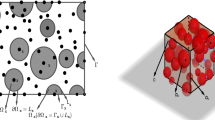Abstract
In this paper, we propose a fast explicit operator splitting method to solve the modified Buckley–Leverett equations which include a third-order mixed derivatives term resulting from the dynamic effects in the pressure difference between the two phases. The method splits the original equation into two equations, one with a nonlinear convective term and the other one with high-order linear terms so that appropriate numerical methods can be applied to each of the split equations: the high-order linear equation is numerically solved using a pseudo-spectral method, while the nonlinear convective equation is integrated using the Godunov-type central-upwind scheme. The spatial order of the central-upwind scheme depends on the order of the piecewise polynomial reconstruction: we test both the second-order minmod-based reconstruction and fifth-order WENO5 one to demonstrate that using higher-order spatial reconstruction leads to more accurate approximation of solutions. A variety of numerical examples in both one and two space dimensions show that the solutions may have many different saturation profiles depending on the initial conditions, diffusion parameter, and the third-order mixed derivatives parameter. The results are consistent with the study of traveling wave solutions and their bifurcation diagrams.













Similar content being viewed by others
References
Barenblatt, G.I., Garcia-Azorero, J., De Pablo, A., Vazquez, J.L.: Mathematical model of the non-equilibrium water-oil displacement in porous strata. Appl. Anal. 65, 19–45 (1997)
Buckley, S.E., Leverett, M.C.: Mechanism of fluid displacement in sands. Pet. Trans. AIME 146, 107–116 (1942)
Chertock, A., Kashdan, E., Kurganov, A.: Propagation of Diffusing Pollutant by a Hybrid Eulerian–Lagrangian method, in Hyperbolic Problems: Theory, Numerics, Applications. Springer, Berlin (2008)
Chertock, A., Kurganov, A.: On splitting-based numerical methods for convection-diffusion equations. In: Numerical Methods for Balance Laws, vol. 24 of Quad. Mat., pp. 303–343. Department of Mathematics, Seconda University, Napoli, Caserta (2009)
Chertock, A., Kurganov, A., Petrova, G.: Fast explicit operator splitting method. Application to the polymer system. In: Finite Volumes for Complex Applications IV, pp. 63–72. ISTE, London (2005)
Chertock, A., Kurganov, A., Petrova, G.: Fast explicit operator splitting method for convection-diffusion equations. Int. J. Numer. Methods Fluids 59, 309–332 (2009)
Cuesta, C., van Duijn, C.J., Hulshof, J.: Infiltration in porous media with dynamic capillary pressure: travelling waves. Eur. J. Appl. Math. 11, 381–397 (2000)
DiCarlo, D.A.: Experimental measurements of saturation overshoot on infiltration. Water Resour. Res. 40, W04215.1–W04215.9 (2004)
Gottlieb, S., Ketcheson, D., Shu, C.-W.: Strong Stability Preserving Runge–Kutta and Multistep Time Discretizations. World Scientific, Hackensack (2011)
Gottlieb, S., Shu, C.-W., Tadmor, E.: Strong stability-preserving high-order time discretization methods. SIAM Rev. 43, 89–112 (2001)
Hassanizadeh, S., Gray, W.G.: Thermodynamic basis of capillary pressure in porous media. Water Resour. Res. 29, 3389–3405 (1993)
Hassanizadeh, S.M., Gray, W.G.: Mechanics and thermodynamics of multiphase flow in porous media including interphase boundaries. Adv. Water Resour. 13, 169–186 (1990)
Johnson, I.W., Wathen, A.J., Baines, M.J.: Moving finite element methods for evolutionary problems. II. Applications. J. Comput. Phys. 79, 270–297 (1988)
Kurganov, A., Lin, C.-T.: On the reduction of numerical dissipation in central-upwind schemes. Commun. Comput. Phys. 2, 141–163 (2007)
Kurganov, A., Noelle, S., Petrova, G.: Semidiscrete central-upwind schemes for hyperbolic conservation laws and Hamilton–Jacobi equations. SIAM J. Sci. Comput. 23, 707–740 (2001). (electronic)
Kurganov, A., Petrova, G., Popov, B.: Adaptive semi-discrete central-upwind schemes for nonconvex hyperbolic conservation laws. SIAM J. Sci. Comput. 29, 2381–2401 (2007)
Lie, K.-A., Noelle, S.: On the artificial compression method for second-order nonoscillatory central difference schemes for systems of conservation laws. SIAM J. Sci. Comput. 24, 1157–1174 (2003)
Nessyahu, H., Tadmor, E.: Nonoscillatory central differencing for hyperbolic conservation laws. J. Comput. Phys. 87, 408–463 (1990)
Shu, C.-W.: Essentially non-oscillatory and weighted essentially non-oscillatory schemes for hyperbolic conservation laws. In: Advanced Numerical Approximation of Nonlinear Hyperbolic Equations (Cetraro, 1997) vol. 1697 of Lecture Notes in Mathematics, pp. 325–432. Springer, Berlin (1998)
Shu, C.-W.: High order weighted essentially nonoscillatory schemes for convection dominated problems. SIAM Rev. 51, 82–126 (2009)
Spayd, K., Shearer, M.: The Buckley-Leverett equation with dynamic capillary pressure. SIAM J. Appl. Math. 71, 1088–1108 (2011)
Sweby, P.K.: High resolution schemes using flux limiters for hyperbolic conservation laws. SIAM J. Numer. Anal. 21, 995–1011 (1984)
van Duijn, C.J., Mikelic, A., Pop, I.S.: Buckley-Leverett, Effective, equations by homogenization. In: Progress in Industrial Mathematics at ECMI 2000 (Palermo), vol. 1 of Math. Ind., pp. 2–51. Springer, Berlin (2002)
van Duijn, C.J., Mikelić, A., Pop, I.S.: Effective equations for two-phase flow with trapping on the micro scale. SIAM J. Appl. Math. 62, 1531–1568 (2002). (electronic)
van Duijn, C.J., Peletier, L.A., Pop, I.S.: A new class of entropy solutions of the Buckley-Leverett equation. SIAM J. Math. Anal. 39, 507–536 (2007). (electronic)
van Leer, B.: Towards the ultimate conservative difference scheme. V. A second-order sequel to Godunov’s method. J. Comput. Phys. 32, 101–136 (1979)
Wang, Y.: Central schemes for the modified Buckley-Leverett equation. PhD thesis, The Ohio State University (2010)
Wang, Y., Kao, C.-Y.: Central schemes for the modified Buckley-Leverett equation. J. Comput. Sci. 4, 12–23 (2013)
Wathen, A.J.: Moving finite elements and oil reseruoir modelàng. PhD thesis, University of Reading, UK (1984)
Acknowledgments
The work of C.-Y. Kao was supported in part by the NSF Grant DMS-1318364. The work of A. Kurganov and Z. Qu was supported in part by the NSF Grant DMS-1115718.
Author information
Authors and Affiliations
Corresponding author
Rights and permissions
About this article
Cite this article
Kao, CY., Kurganov, A., Qu, Z. et al. A Fast Explicit Operator Splitting Method for Modified Buckley–Leverett Equations. J Sci Comput 64, 837–857 (2015). https://doi.org/10.1007/s10915-014-9950-x
Received:
Revised:
Accepted:
Published:
Issue Date:
DOI: https://doi.org/10.1007/s10915-014-9950-x
Keywords
- Buckley–Leverett equations
- Modified Buckley–Leverett equations
- Fast explicit operator splitting method
- Central-upwind schemes
- Pseudo-spectral methods
- Minmod-based reconstruction
- WENO5 reconstruction




